James Cook University: NS3118 Nursing Assignment Literature Review
VerifiedAdded on 2023/04/25
|10
|2282
|358
Report
AI Summary
This nursing assignment presents a literature review focusing on the effectiveness of cognitive behavioral therapy (CBT) and exercise therapy, with or without antidepressants, in treating depression. The assignment begins with an introduction highlighting the prevalence of depression and the conventional treatments, including both medication and psychotherapy. It poses a PICO question to guide the literature search, focusing on whether CBT and/or exercise are effective alternatives or complements to antidepressant medication. The methodology outlines the search strategy, including the databases used (Google Scholar, PubMed, CINAHL, Medscape), keywords, and inclusion/exclusion criteria. A PRISMA diagram illustrates the article selection process, resulting in five research articles selected for review. The literature review section summarizes the methodology and findings of each selected article, discussing the impact of CBT, exercise, and mindfulness-based cognitive therapy on depression outcomes. The studies included large-scale randomized controlled trials and compared different treatment approaches. The findings suggest that CBT and exercise can be effective in managing depression, potentially reducing the need for antidepressants and improving patient outcomes. The conclusion emphasizes the importance of providing counseling and support in addition to conventional care, highlighting the potential of cognitive therapy and exercise in treating depression. The assignment is a detailed exploration of the current research on depression treatments.
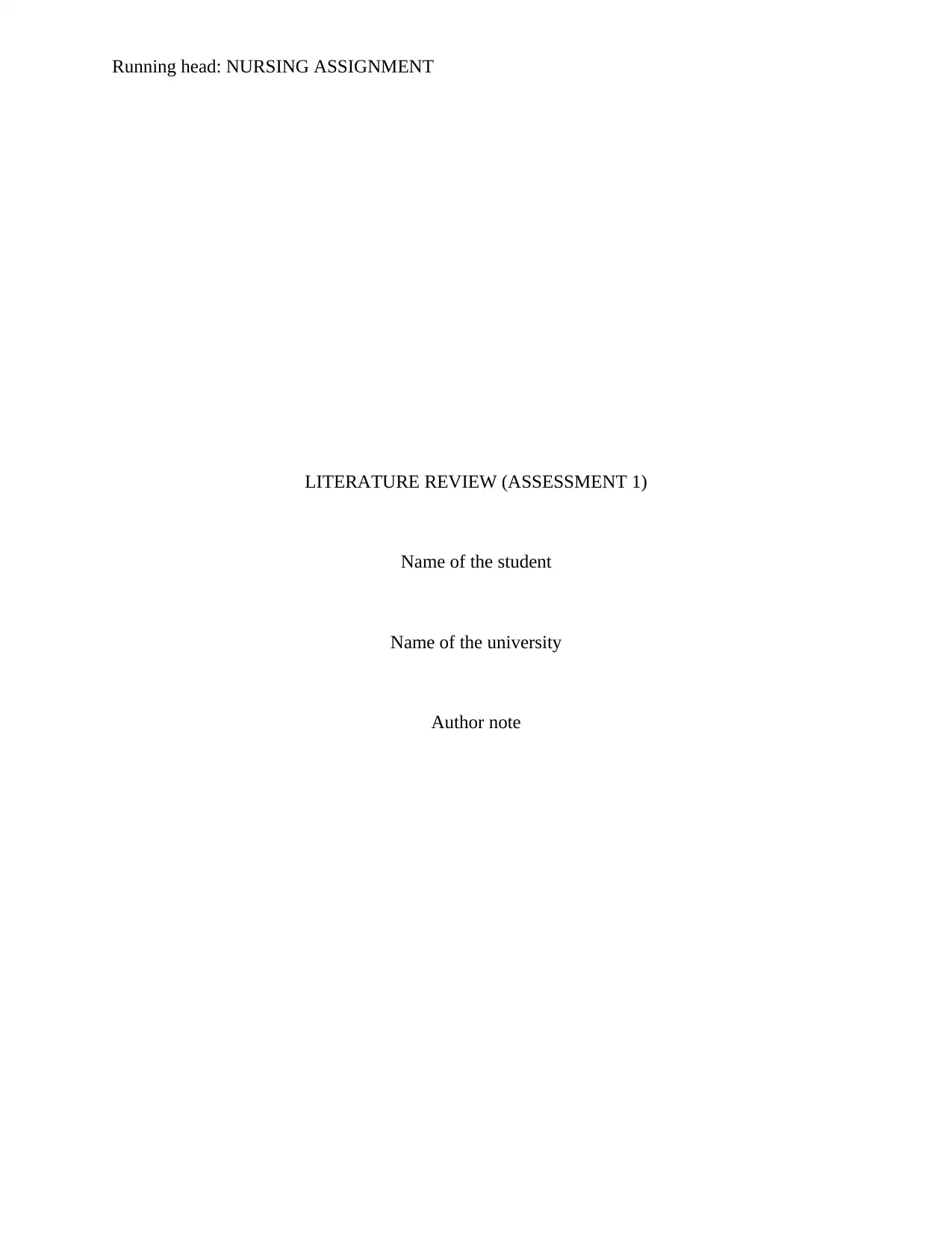
Running head: NURSING ASSIGNMENT
LITERATURE REVIEW (ASSESSMENT 1)
Name of the student
Name of the university
Author note
LITERATURE REVIEW (ASSESSMENT 1)
Name of the student
Name of the university
Author note
Paraphrase This Document
Need a fresh take? Get an instant paraphrase of this document with our AI Paraphraser
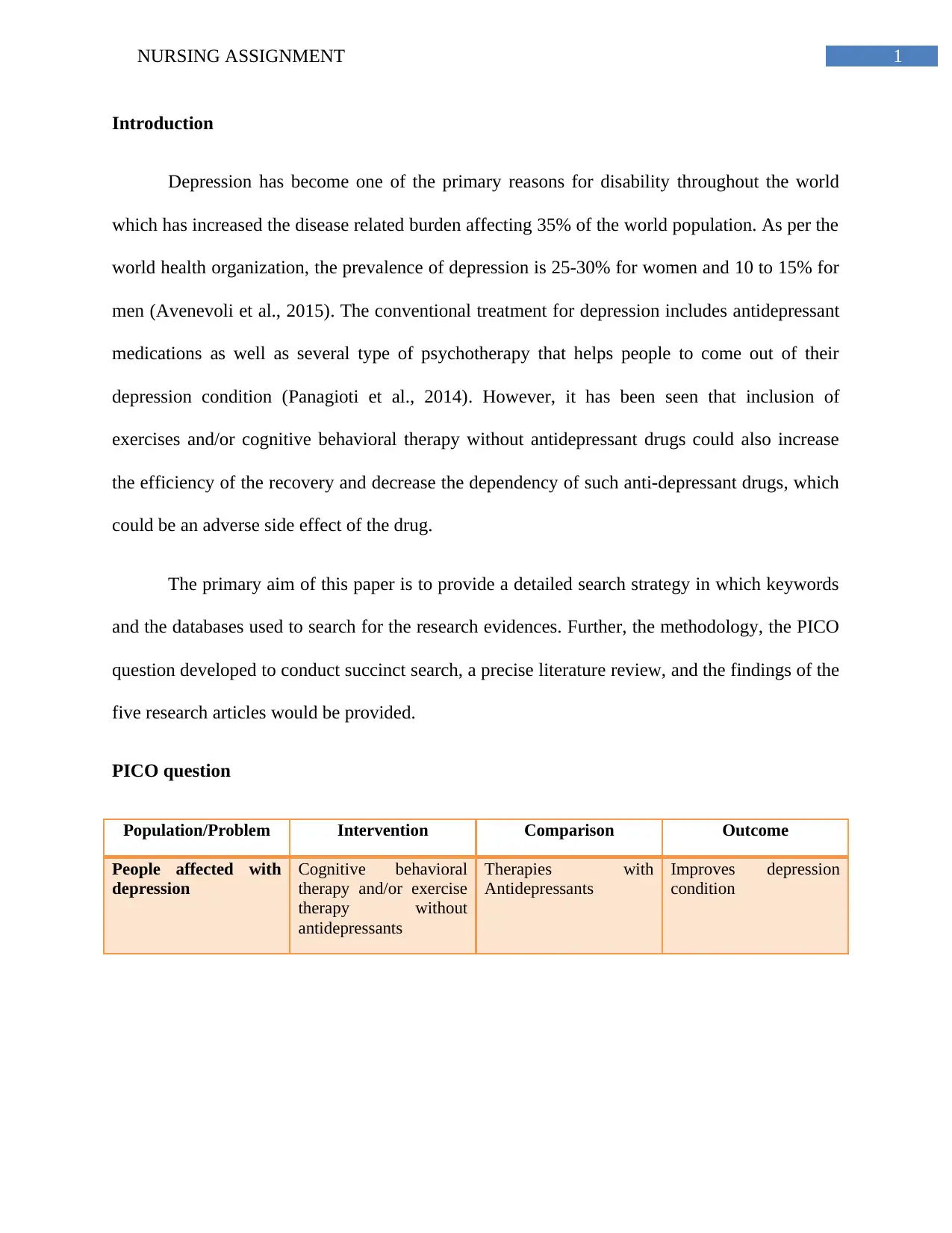
1NURSING ASSIGNMENT
Introduction
Depression has become one of the primary reasons for disability throughout the world
which has increased the disease related burden affecting 35% of the world population. As per the
world health organization, the prevalence of depression is 25-30% for women and 10 to 15% for
men (Avenevoli et al., 2015). The conventional treatment for depression includes antidepressant
medications as well as several type of psychotherapy that helps people to come out of their
depression condition (Panagioti et al., 2014). However, it has been seen that inclusion of
exercises and/or cognitive behavioral therapy without antidepressant drugs could also increase
the efficiency of the recovery and decrease the dependency of such anti-depressant drugs, which
could be an adverse side effect of the drug.
The primary aim of this paper is to provide a detailed search strategy in which keywords
and the databases used to search for the research evidences. Further, the methodology, the PICO
question developed to conduct succinct search, a precise literature review, and the findings of the
five research articles would be provided.
PICO question
Population/Problem Intervention Comparison Outcome
People affected with
depression
Cognitive behavioral
therapy and/or exercise
therapy without
antidepressants
Therapies with
Antidepressants
Improves depression
condition
Introduction
Depression has become one of the primary reasons for disability throughout the world
which has increased the disease related burden affecting 35% of the world population. As per the
world health organization, the prevalence of depression is 25-30% for women and 10 to 15% for
men (Avenevoli et al., 2015). The conventional treatment for depression includes antidepressant
medications as well as several type of psychotherapy that helps people to come out of their
depression condition (Panagioti et al., 2014). However, it has been seen that inclusion of
exercises and/or cognitive behavioral therapy without antidepressant drugs could also increase
the efficiency of the recovery and decrease the dependency of such anti-depressant drugs, which
could be an adverse side effect of the drug.
The primary aim of this paper is to provide a detailed search strategy in which keywords
and the databases used to search for the research evidences. Further, the methodology, the PICO
question developed to conduct succinct search, a precise literature review, and the findings of the
five research articles would be provided.
PICO question
Population/Problem Intervention Comparison Outcome
People affected with
depression
Cognitive behavioral
therapy and/or exercise
therapy without
antidepressants
Therapies with
Antidepressants
Improves depression
condition
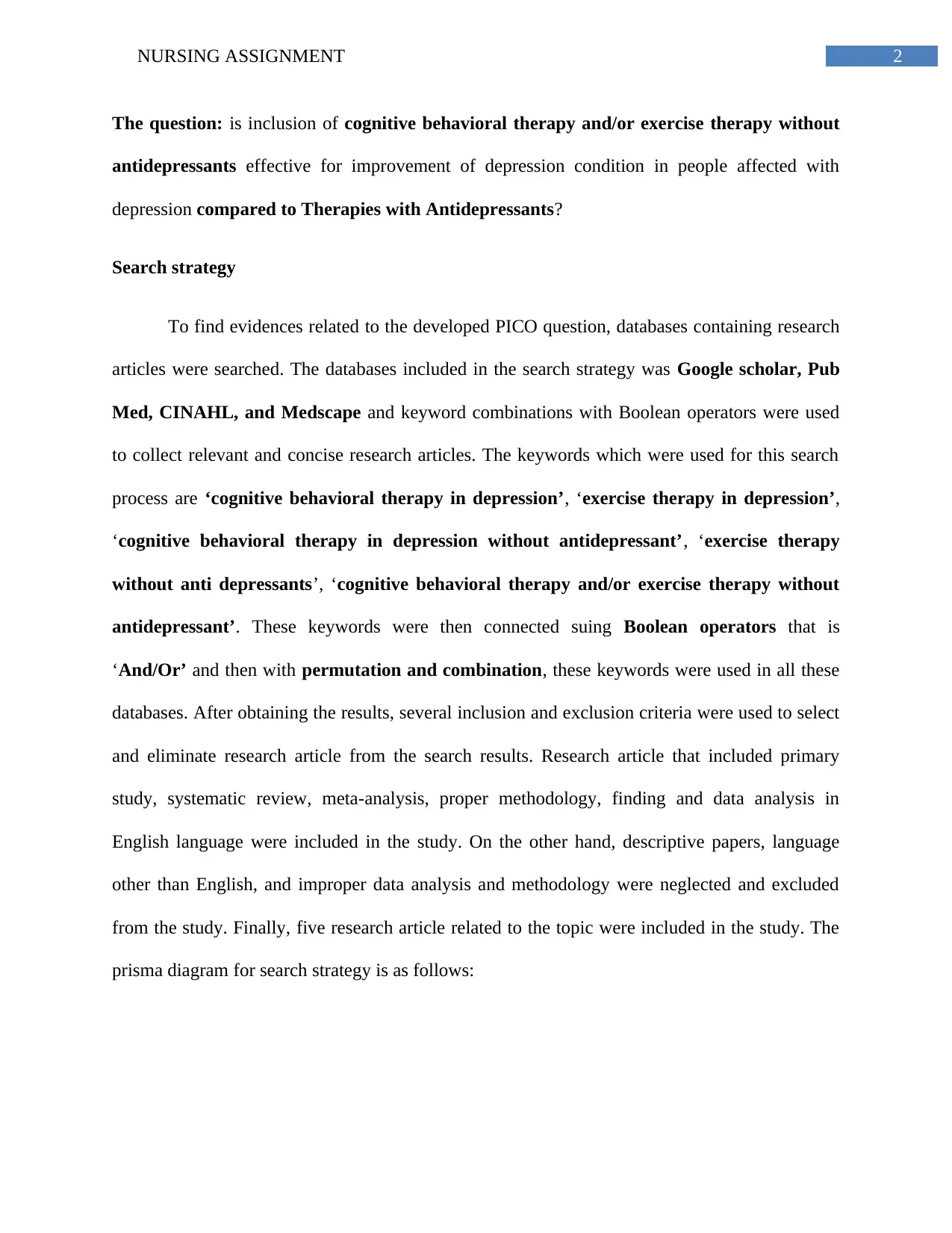
2NURSING ASSIGNMENT
The question: is inclusion of cognitive behavioral therapy and/or exercise therapy without
antidepressants effective for improvement of depression condition in people affected with
depression compared to Therapies with Antidepressants?
Search strategy
To find evidences related to the developed PICO question, databases containing research
articles were searched. The databases included in the search strategy was Google scholar, Pub
Med, CINAHL, and Medscape and keyword combinations with Boolean operators were used
to collect relevant and concise research articles. The keywords which were used for this search
process are ‘cognitive behavioral therapy in depression’, ‘exercise therapy in depression’,
‘cognitive behavioral therapy in depression without antidepressant’, ‘exercise therapy
without anti depressants’, ‘cognitive behavioral therapy and/or exercise therapy without
antidepressant’. These keywords were then connected suing Boolean operators that is
‘And/Or’ and then with permutation and combination, these keywords were used in all these
databases. After obtaining the results, several inclusion and exclusion criteria were used to select
and eliminate research article from the search results. Research article that included primary
study, systematic review, meta-analysis, proper methodology, finding and data analysis in
English language were included in the study. On the other hand, descriptive papers, language
other than English, and improper data analysis and methodology were neglected and excluded
from the study. Finally, five research article related to the topic were included in the study. The
prisma diagram for search strategy is as follows:
The question: is inclusion of cognitive behavioral therapy and/or exercise therapy without
antidepressants effective for improvement of depression condition in people affected with
depression compared to Therapies with Antidepressants?
Search strategy
To find evidences related to the developed PICO question, databases containing research
articles were searched. The databases included in the search strategy was Google scholar, Pub
Med, CINAHL, and Medscape and keyword combinations with Boolean operators were used
to collect relevant and concise research articles. The keywords which were used for this search
process are ‘cognitive behavioral therapy in depression’, ‘exercise therapy in depression’,
‘cognitive behavioral therapy in depression without antidepressant’, ‘exercise therapy
without anti depressants’, ‘cognitive behavioral therapy and/or exercise therapy without
antidepressant’. These keywords were then connected suing Boolean operators that is
‘And/Or’ and then with permutation and combination, these keywords were used in all these
databases. After obtaining the results, several inclusion and exclusion criteria were used to select
and eliminate research article from the search results. Research article that included primary
study, systematic review, meta-analysis, proper methodology, finding and data analysis in
English language were included in the study. On the other hand, descriptive papers, language
other than English, and improper data analysis and methodology were neglected and excluded
from the study. Finally, five research article related to the topic were included in the study. The
prisma diagram for search strategy is as follows:
⊘ This is a preview!⊘
Do you want full access?
Subscribe today to unlock all pages.

Trusted by 1+ million students worldwide
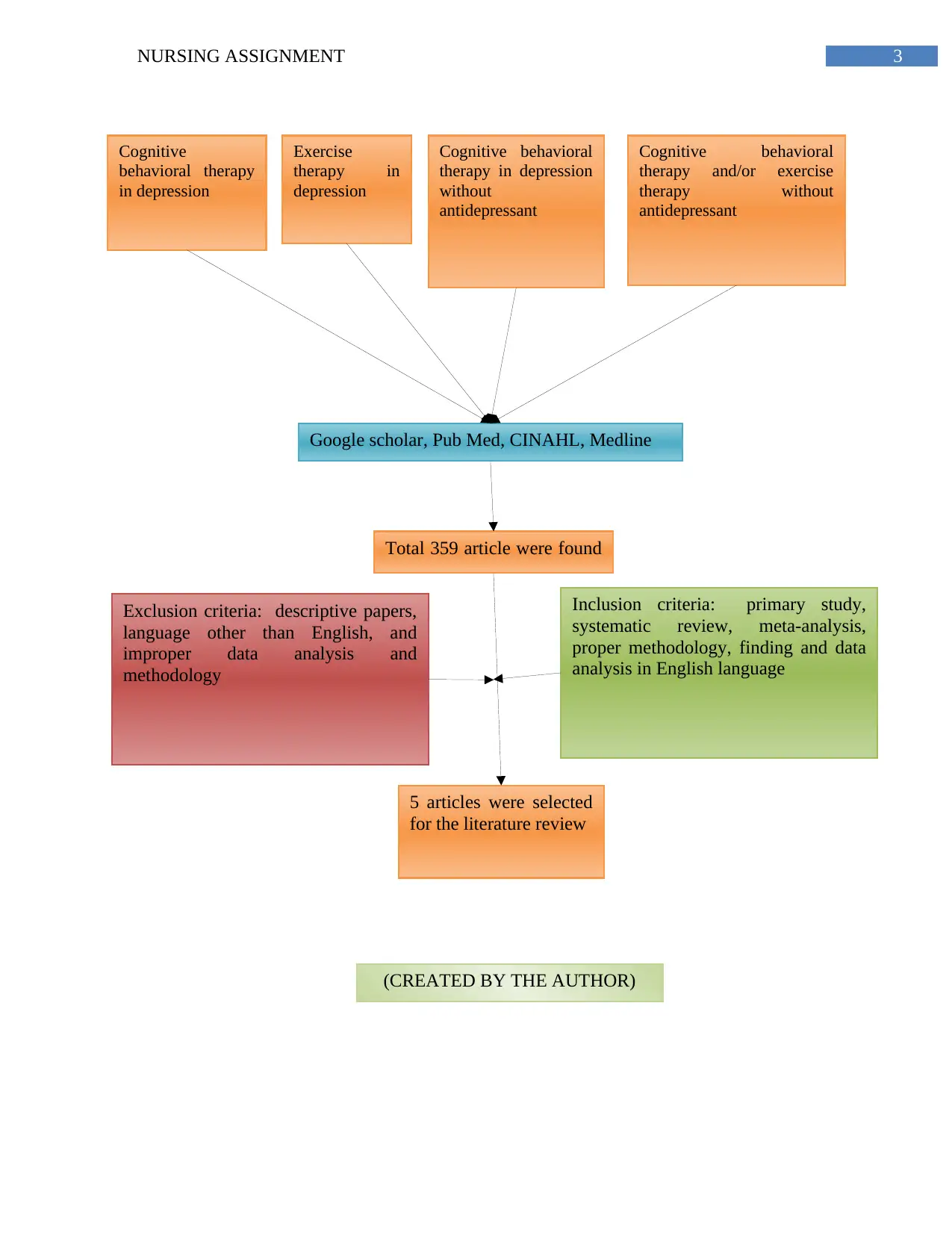
3NURSING ASSIGNMENT
Cognitive
behavioral therapy
in depression
Exercise
therapy in
depression
Cognitive behavioral
therapy in depression
without
antidepressant
Google scholar, Pub Med, CINAHL, Medline
Cognitive behavioral
therapy and/or exercise
therapy without
antidepressant
Total 359 article were found
5 articles were selected
for the literature review
Inclusion criteria: primary study,
systematic review, meta-analysis,
proper methodology, finding and data
analysis in English language
Exclusion criteria: descriptive papers,
language other than English, and
improper data analysis and
methodology
(CREATED BY THE AUTHOR)
Cognitive
behavioral therapy
in depression
Exercise
therapy in
depression
Cognitive behavioral
therapy in depression
without
antidepressant
Google scholar, Pub Med, CINAHL, Medline
Cognitive behavioral
therapy and/or exercise
therapy without
antidepressant
Total 359 article were found
5 articles were selected
for the literature review
Inclusion criteria: primary study,
systematic review, meta-analysis,
proper methodology, finding and data
analysis in English language
Exclusion criteria: descriptive papers,
language other than English, and
improper data analysis and
methodology
(CREATED BY THE AUTHOR)
Paraphrase This Document
Need a fresh take? Get an instant paraphrase of this document with our AI Paraphraser
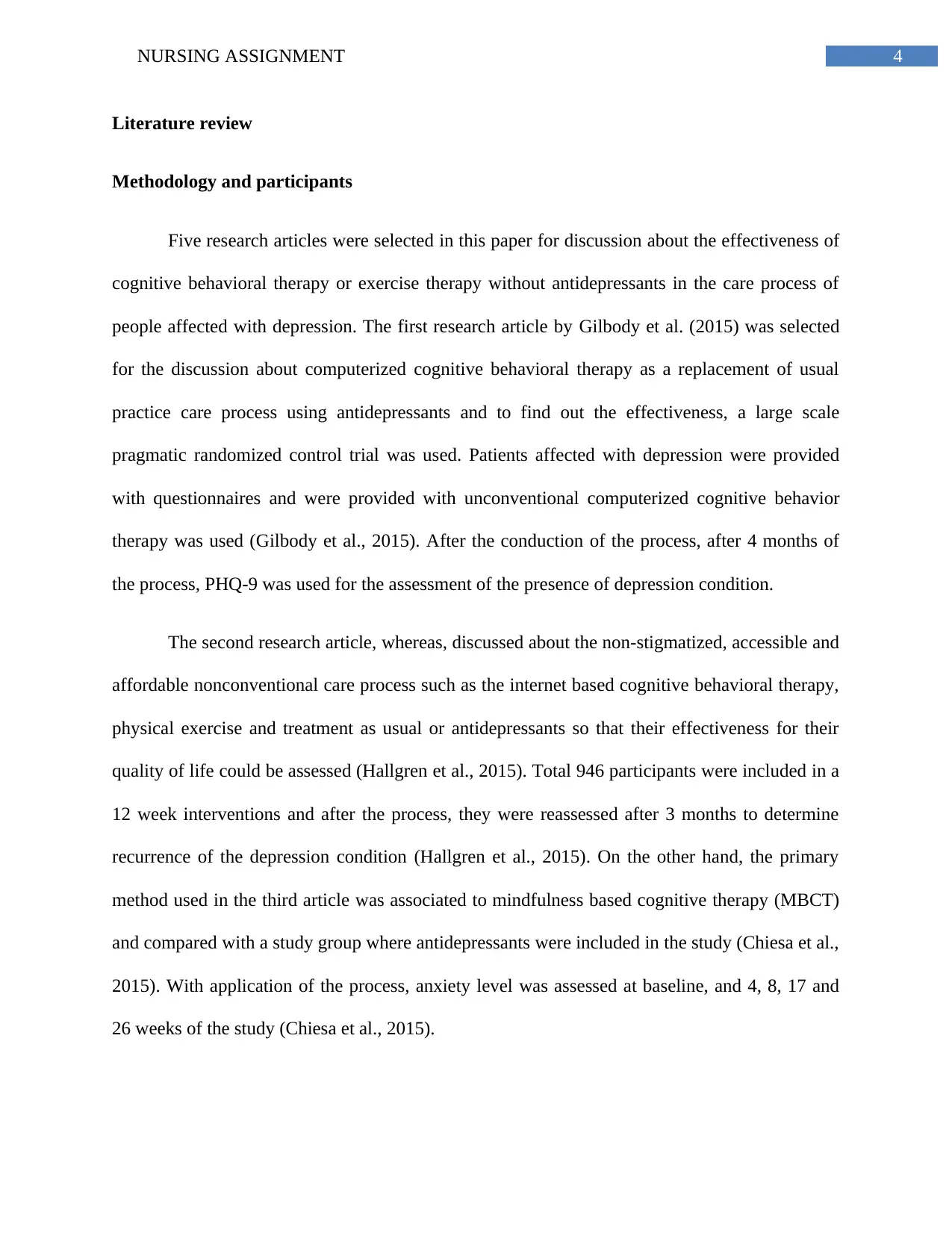
4NURSING ASSIGNMENT
Literature review
Methodology and participants
Five research articles were selected in this paper for discussion about the effectiveness of
cognitive behavioral therapy or exercise therapy without antidepressants in the care process of
people affected with depression. The first research article by Gilbody et al. (2015) was selected
for the discussion about computerized cognitive behavioral therapy as a replacement of usual
practice care process using antidepressants and to find out the effectiveness, a large scale
pragmatic randomized control trial was used. Patients affected with depression were provided
with questionnaires and were provided with unconventional computerized cognitive behavior
therapy was used (Gilbody et al., 2015). After the conduction of the process, after 4 months of
the process, PHQ-9 was used for the assessment of the presence of depression condition.
The second research article, whereas, discussed about the non-stigmatized, accessible and
affordable nonconventional care process such as the internet based cognitive behavioral therapy,
physical exercise and treatment as usual or antidepressants so that their effectiveness for their
quality of life could be assessed (Hallgren et al., 2015). Total 946 participants were included in a
12 week interventions and after the process, they were reassessed after 3 months to determine
recurrence of the depression condition (Hallgren et al., 2015). On the other hand, the primary
method used in the third article was associated to mindfulness based cognitive therapy (MBCT)
and compared with a study group where antidepressants were included in the study (Chiesa et al.,
2015). With application of the process, anxiety level was assessed at baseline, and 4, 8, 17 and
26 weeks of the study (Chiesa et al., 2015).
Literature review
Methodology and participants
Five research articles were selected in this paper for discussion about the effectiveness of
cognitive behavioral therapy or exercise therapy without antidepressants in the care process of
people affected with depression. The first research article by Gilbody et al. (2015) was selected
for the discussion about computerized cognitive behavioral therapy as a replacement of usual
practice care process using antidepressants and to find out the effectiveness, a large scale
pragmatic randomized control trial was used. Patients affected with depression were provided
with questionnaires and were provided with unconventional computerized cognitive behavior
therapy was used (Gilbody et al., 2015). After the conduction of the process, after 4 months of
the process, PHQ-9 was used for the assessment of the presence of depression condition.
The second research article, whereas, discussed about the non-stigmatized, accessible and
affordable nonconventional care process such as the internet based cognitive behavioral therapy,
physical exercise and treatment as usual or antidepressants so that their effectiveness for their
quality of life could be assessed (Hallgren et al., 2015). Total 946 participants were included in a
12 week interventions and after the process, they were reassessed after 3 months to determine
recurrence of the depression condition (Hallgren et al., 2015). On the other hand, the primary
method used in the third article was associated to mindfulness based cognitive therapy (MBCT)
and compared with a study group where antidepressants were included in the study (Chiesa et al.,
2015). With application of the process, anxiety level was assessed at baseline, and 4, 8, 17 and
26 weeks of the study (Chiesa et al., 2015).
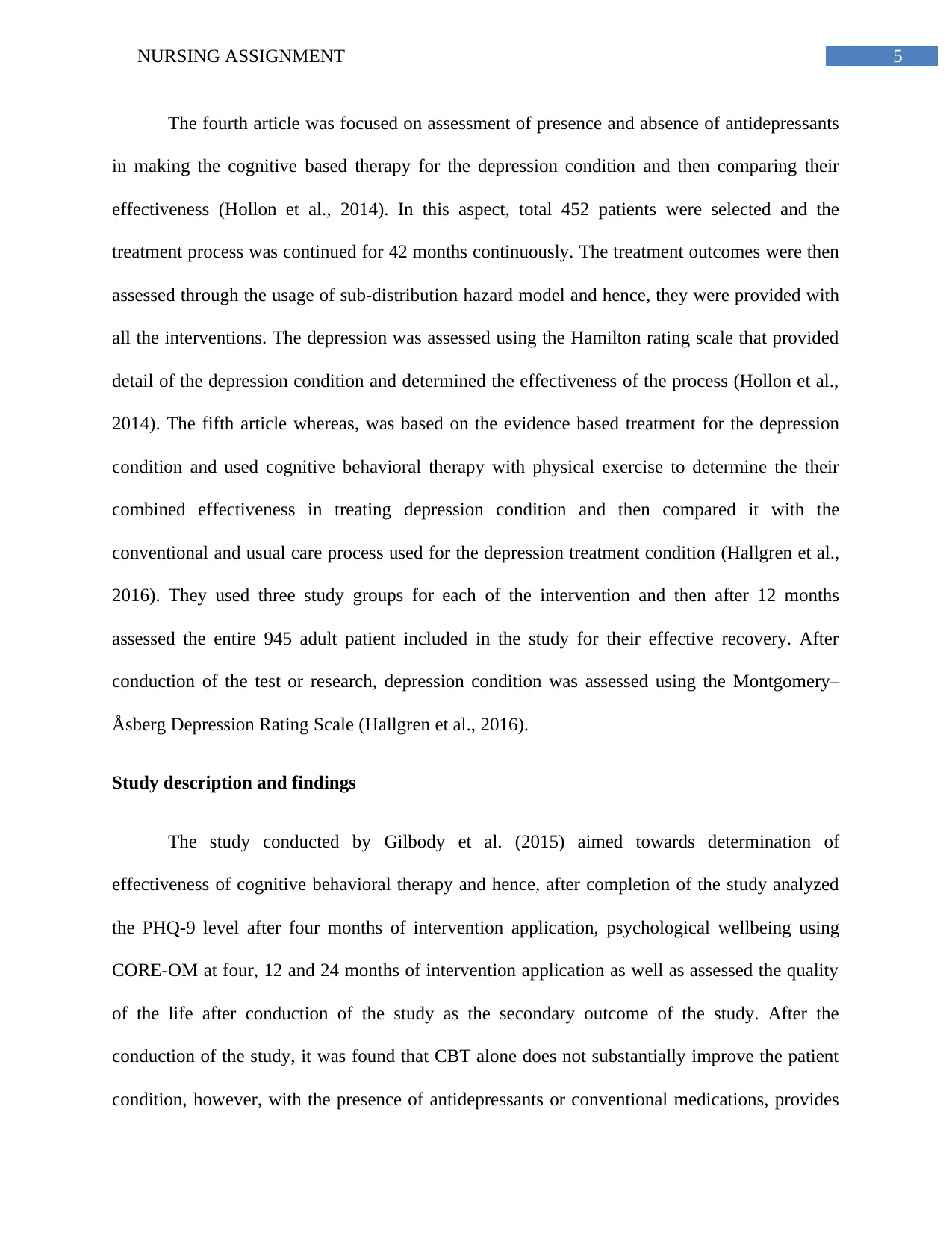
5NURSING ASSIGNMENT
The fourth article was focused on assessment of presence and absence of antidepressants
in making the cognitive based therapy for the depression condition and then comparing their
effectiveness (Hollon et al., 2014). In this aspect, total 452 patients were selected and the
treatment process was continued for 42 months continuously. The treatment outcomes were then
assessed through the usage of sub-distribution hazard model and hence, they were provided with
all the interventions. The depression was assessed using the Hamilton rating scale that provided
detail of the depression condition and determined the effectiveness of the process (Hollon et al.,
2014). The fifth article whereas, was based on the evidence based treatment for the depression
condition and used cognitive behavioral therapy with physical exercise to determine the their
combined effectiveness in treating depression condition and then compared it with the
conventional and usual care process used for the depression treatment condition (Hallgren et al.,
2016). They used three study groups for each of the intervention and then after 12 months
assessed the entire 945 adult patient included in the study for their effective recovery. After
conduction of the test or research, depression condition was assessed using the Montgomery–
Åsberg Depression Rating Scale (Hallgren et al., 2016).
Study description and findings
The study conducted by Gilbody et al. (2015) aimed towards determination of
effectiveness of cognitive behavioral therapy and hence, after completion of the study analyzed
the PHQ-9 level after four months of intervention application, psychological wellbeing using
CORE-OM at four, 12 and 24 months of intervention application as well as assessed the quality
of the life after conduction of the study as the secondary outcome of the study. After the
conduction of the study, it was found that CBT alone does not substantially improve the patient
condition, however, with the presence of antidepressants or conventional medications, provides
The fourth article was focused on assessment of presence and absence of antidepressants
in making the cognitive based therapy for the depression condition and then comparing their
effectiveness (Hollon et al., 2014). In this aspect, total 452 patients were selected and the
treatment process was continued for 42 months continuously. The treatment outcomes were then
assessed through the usage of sub-distribution hazard model and hence, they were provided with
all the interventions. The depression was assessed using the Hamilton rating scale that provided
detail of the depression condition and determined the effectiveness of the process (Hollon et al.,
2014). The fifth article whereas, was based on the evidence based treatment for the depression
condition and used cognitive behavioral therapy with physical exercise to determine the their
combined effectiveness in treating depression condition and then compared it with the
conventional and usual care process used for the depression treatment condition (Hallgren et al.,
2016). They used three study groups for each of the intervention and then after 12 months
assessed the entire 945 adult patient included in the study for their effective recovery. After
conduction of the test or research, depression condition was assessed using the Montgomery–
Åsberg Depression Rating Scale (Hallgren et al., 2016).
Study description and findings
The study conducted by Gilbody et al. (2015) aimed towards determination of
effectiveness of cognitive behavioral therapy and hence, after completion of the study analyzed
the PHQ-9 level after four months of intervention application, psychological wellbeing using
CORE-OM at four, 12 and 24 months of intervention application as well as assessed the quality
of the life after conduction of the study as the secondary outcome of the study. After the
conduction of the study, it was found that CBT alone does not substantially improve the patient
condition, however, with the presence of antidepressants or conventional medications, provides
⊘ This is a preview!⊘
Do you want full access?
Subscribe today to unlock all pages.

Trusted by 1+ million students worldwide
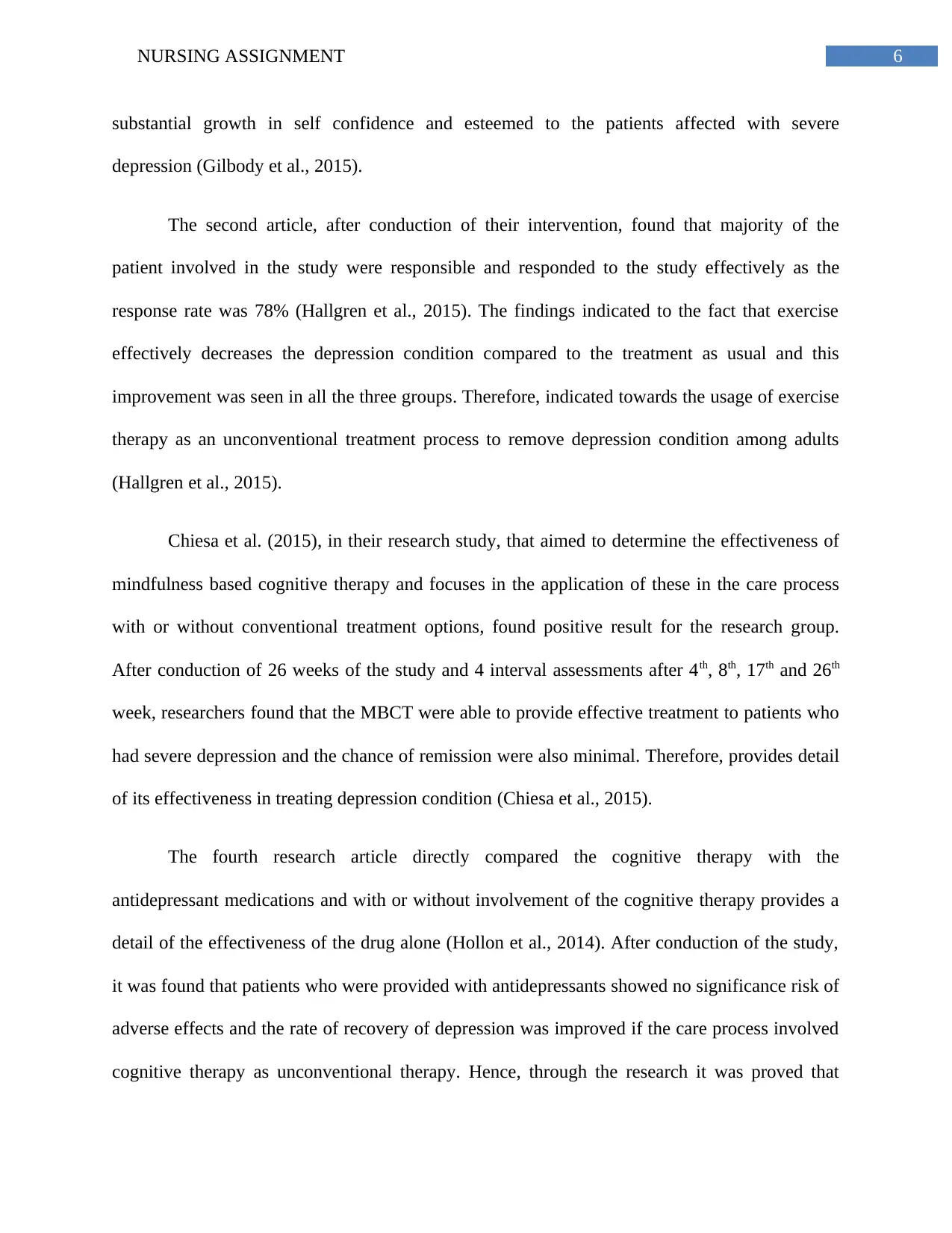
6NURSING ASSIGNMENT
substantial growth in self confidence and esteemed to the patients affected with severe
depression (Gilbody et al., 2015).
The second article, after conduction of their intervention, found that majority of the
patient involved in the study were responsible and responded to the study effectively as the
response rate was 78% (Hallgren et al., 2015). The findings indicated to the fact that exercise
effectively decreases the depression condition compared to the treatment as usual and this
improvement was seen in all the three groups. Therefore, indicated towards the usage of exercise
therapy as an unconventional treatment process to remove depression condition among adults
(Hallgren et al., 2015).
Chiesa et al. (2015), in their research study, that aimed to determine the effectiveness of
mindfulness based cognitive therapy and focuses in the application of these in the care process
with or without conventional treatment options, found positive result for the research group.
After conduction of 26 weeks of the study and 4 interval assessments after 4th, 8th, 17th and 26th
week, researchers found that the MBCT were able to provide effective treatment to patients who
had severe depression and the chance of remission were also minimal. Therefore, provides detail
of its effectiveness in treating depression condition (Chiesa et al., 2015).
The fourth research article directly compared the cognitive therapy with the
antidepressant medications and with or without involvement of the cognitive therapy provides a
detail of the effectiveness of the drug alone (Hollon et al., 2014). After conduction of the study,
it was found that patients who were provided with antidepressants showed no significance risk of
adverse effects and the rate of recovery of depression was improved if the care process involved
cognitive therapy as unconventional therapy. Hence, through the research it was proved that
substantial growth in self confidence and esteemed to the patients affected with severe
depression (Gilbody et al., 2015).
The second article, after conduction of their intervention, found that majority of the
patient involved in the study were responsible and responded to the study effectively as the
response rate was 78% (Hallgren et al., 2015). The findings indicated to the fact that exercise
effectively decreases the depression condition compared to the treatment as usual and this
improvement was seen in all the three groups. Therefore, indicated towards the usage of exercise
therapy as an unconventional treatment process to remove depression condition among adults
(Hallgren et al., 2015).
Chiesa et al. (2015), in their research study, that aimed to determine the effectiveness of
mindfulness based cognitive therapy and focuses in the application of these in the care process
with or without conventional treatment options, found positive result for the research group.
After conduction of 26 weeks of the study and 4 interval assessments after 4th, 8th, 17th and 26th
week, researchers found that the MBCT were able to provide effective treatment to patients who
had severe depression and the chance of remission were also minimal. Therefore, provides detail
of its effectiveness in treating depression condition (Chiesa et al., 2015).
The fourth research article directly compared the cognitive therapy with the
antidepressant medications and with or without involvement of the cognitive therapy provides a
detail of the effectiveness of the drug alone (Hollon et al., 2014). After conduction of the study,
it was found that patients who were provided with antidepressants showed no significance risk of
adverse effects and the rate of recovery of depression was improved if the care process involved
cognitive therapy as unconventional therapy. Hence, through the research it was proved that
Paraphrase This Document
Need a fresh take? Get an instant paraphrase of this document with our AI Paraphraser
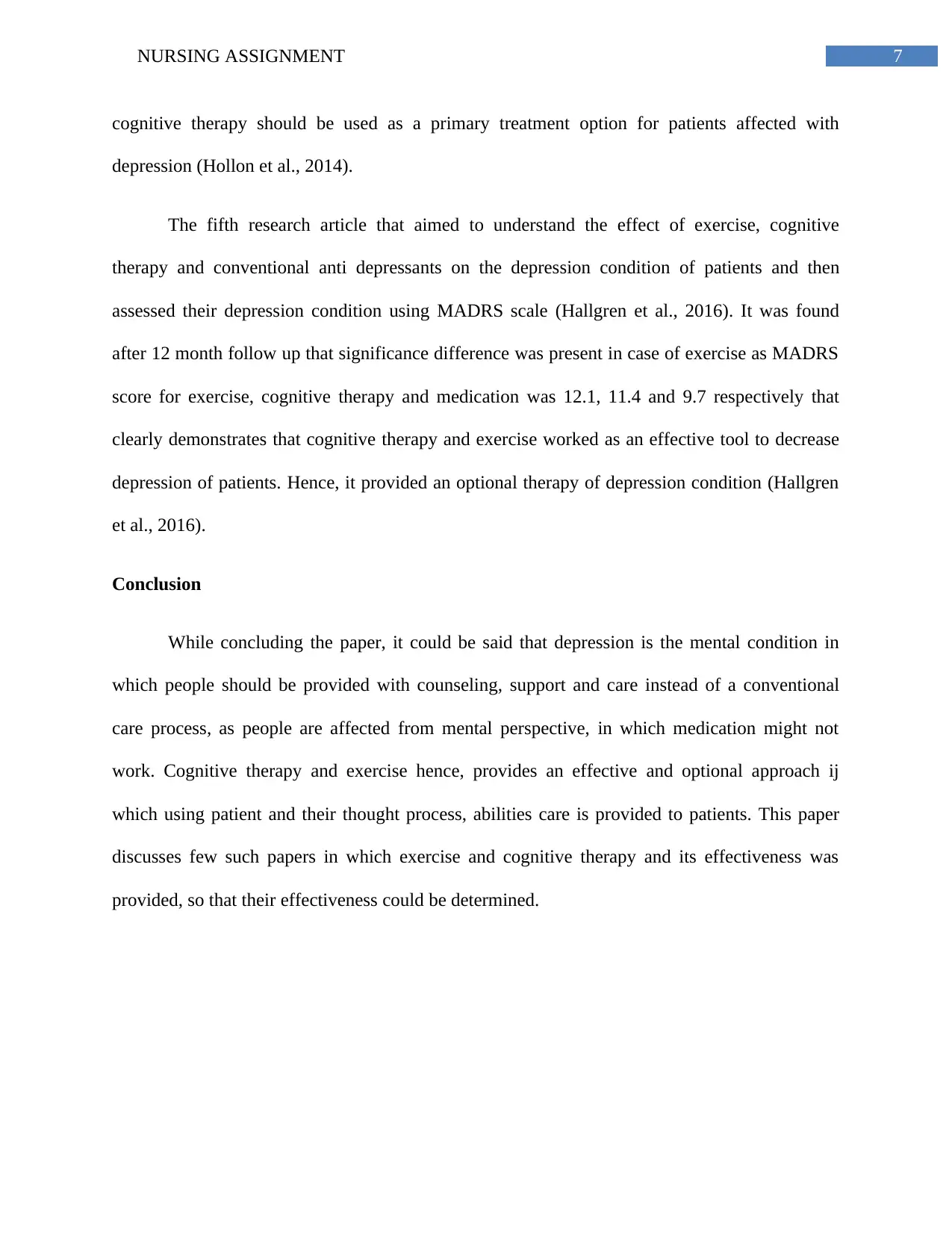
7NURSING ASSIGNMENT
cognitive therapy should be used as a primary treatment option for patients affected with
depression (Hollon et al., 2014).
The fifth research article that aimed to understand the effect of exercise, cognitive
therapy and conventional anti depressants on the depression condition of patients and then
assessed their depression condition using MADRS scale (Hallgren et al., 2016). It was found
after 12 month follow up that significance difference was present in case of exercise as MADRS
score for exercise, cognitive therapy and medication was 12.1, 11.4 and 9.7 respectively that
clearly demonstrates that cognitive therapy and exercise worked as an effective tool to decrease
depression of patients. Hence, it provided an optional therapy of depression condition (Hallgren
et al., 2016).
Conclusion
While concluding the paper, it could be said that depression is the mental condition in
which people should be provided with counseling, support and care instead of a conventional
care process, as people are affected from mental perspective, in which medication might not
work. Cognitive therapy and exercise hence, provides an effective and optional approach ij
which using patient and their thought process, abilities care is provided to patients. This paper
discusses few such papers in which exercise and cognitive therapy and its effectiveness was
provided, so that their effectiveness could be determined.
cognitive therapy should be used as a primary treatment option for patients affected with
depression (Hollon et al., 2014).
The fifth research article that aimed to understand the effect of exercise, cognitive
therapy and conventional anti depressants on the depression condition of patients and then
assessed their depression condition using MADRS scale (Hallgren et al., 2016). It was found
after 12 month follow up that significance difference was present in case of exercise as MADRS
score for exercise, cognitive therapy and medication was 12.1, 11.4 and 9.7 respectively that
clearly demonstrates that cognitive therapy and exercise worked as an effective tool to decrease
depression of patients. Hence, it provided an optional therapy of depression condition (Hallgren
et al., 2016).
Conclusion
While concluding the paper, it could be said that depression is the mental condition in
which people should be provided with counseling, support and care instead of a conventional
care process, as people are affected from mental perspective, in which medication might not
work. Cognitive therapy and exercise hence, provides an effective and optional approach ij
which using patient and their thought process, abilities care is provided to patients. This paper
discusses few such papers in which exercise and cognitive therapy and its effectiveness was
provided, so that their effectiveness could be determined.
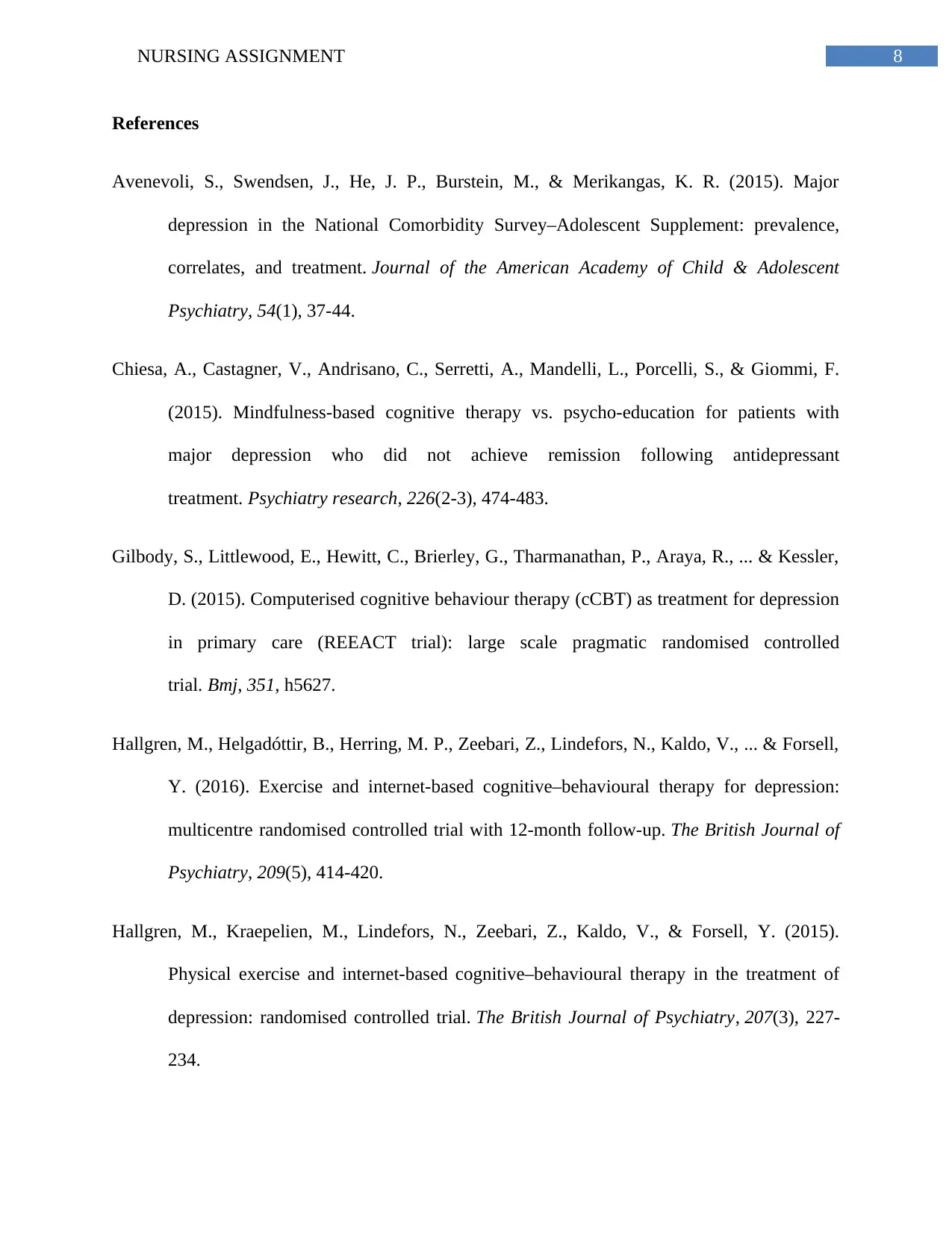
8NURSING ASSIGNMENT
References
Avenevoli, S., Swendsen, J., He, J. P., Burstein, M., & Merikangas, K. R. (2015). Major
depression in the National Comorbidity Survey–Adolescent Supplement: prevalence,
correlates, and treatment. Journal of the American Academy of Child & Adolescent
Psychiatry, 54(1), 37-44.
Chiesa, A., Castagner, V., Andrisano, C., Serretti, A., Mandelli, L., Porcelli, S., & Giommi, F.
(2015). Mindfulness-based cognitive therapy vs. psycho-education for patients with
major depression who did not achieve remission following antidepressant
treatment. Psychiatry research, 226(2-3), 474-483.
Gilbody, S., Littlewood, E., Hewitt, C., Brierley, G., Tharmanathan, P., Araya, R., ... & Kessler,
D. (2015). Computerised cognitive behaviour therapy (cCBT) as treatment for depression
in primary care (REEACT trial): large scale pragmatic randomised controlled
trial. Bmj, 351, h5627.
Hallgren, M., Helgadóttir, B., Herring, M. P., Zeebari, Z., Lindefors, N., Kaldo, V., ... & Forsell,
Y. (2016). Exercise and internet-based cognitive–behavioural therapy for depression:
multicentre randomised controlled trial with 12-month follow-up. The British Journal of
Psychiatry, 209(5), 414-420.
Hallgren, M., Kraepelien, M., Lindefors, N., Zeebari, Z., Kaldo, V., & Forsell, Y. (2015).
Physical exercise and internet-based cognitive–behavioural therapy in the treatment of
depression: randomised controlled trial. The British Journal of Psychiatry, 207(3), 227-
234.
References
Avenevoli, S., Swendsen, J., He, J. P., Burstein, M., & Merikangas, K. R. (2015). Major
depression in the National Comorbidity Survey–Adolescent Supplement: prevalence,
correlates, and treatment. Journal of the American Academy of Child & Adolescent
Psychiatry, 54(1), 37-44.
Chiesa, A., Castagner, V., Andrisano, C., Serretti, A., Mandelli, L., Porcelli, S., & Giommi, F.
(2015). Mindfulness-based cognitive therapy vs. psycho-education for patients with
major depression who did not achieve remission following antidepressant
treatment. Psychiatry research, 226(2-3), 474-483.
Gilbody, S., Littlewood, E., Hewitt, C., Brierley, G., Tharmanathan, P., Araya, R., ... & Kessler,
D. (2015). Computerised cognitive behaviour therapy (cCBT) as treatment for depression
in primary care (REEACT trial): large scale pragmatic randomised controlled
trial. Bmj, 351, h5627.
Hallgren, M., Helgadóttir, B., Herring, M. P., Zeebari, Z., Lindefors, N., Kaldo, V., ... & Forsell,
Y. (2016). Exercise and internet-based cognitive–behavioural therapy for depression:
multicentre randomised controlled trial with 12-month follow-up. The British Journal of
Psychiatry, 209(5), 414-420.
Hallgren, M., Kraepelien, M., Lindefors, N., Zeebari, Z., Kaldo, V., & Forsell, Y. (2015).
Physical exercise and internet-based cognitive–behavioural therapy in the treatment of
depression: randomised controlled trial. The British Journal of Psychiatry, 207(3), 227-
234.
⊘ This is a preview!⊘
Do you want full access?
Subscribe today to unlock all pages.

Trusted by 1+ million students worldwide
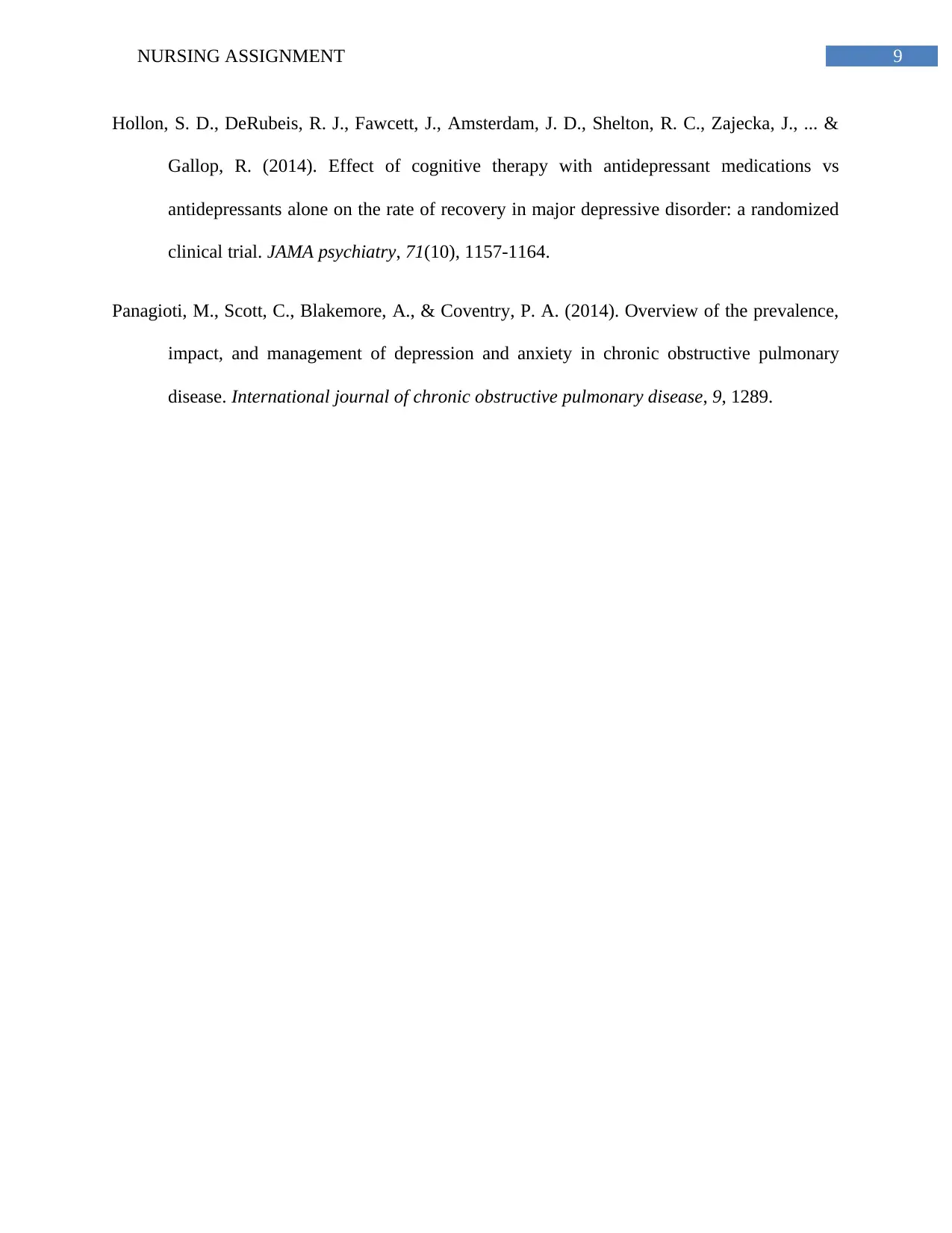
9NURSING ASSIGNMENT
Hollon, S. D., DeRubeis, R. J., Fawcett, J., Amsterdam, J. D., Shelton, R. C., Zajecka, J., ... &
Gallop, R. (2014). Effect of cognitive therapy with antidepressant medications vs
antidepressants alone on the rate of recovery in major depressive disorder: a randomized
clinical trial. JAMA psychiatry, 71(10), 1157-1164.
Panagioti, M., Scott, C., Blakemore, A., & Coventry, P. A. (2014). Overview of the prevalence,
impact, and management of depression and anxiety in chronic obstructive pulmonary
disease. International journal of chronic obstructive pulmonary disease, 9, 1289.
Hollon, S. D., DeRubeis, R. J., Fawcett, J., Amsterdam, J. D., Shelton, R. C., Zajecka, J., ... &
Gallop, R. (2014). Effect of cognitive therapy with antidepressant medications vs
antidepressants alone on the rate of recovery in major depressive disorder: a randomized
clinical trial. JAMA psychiatry, 71(10), 1157-1164.
Panagioti, M., Scott, C., Blakemore, A., & Coventry, P. A. (2014). Overview of the prevalence,
impact, and management of depression and anxiety in chronic obstructive pulmonary
disease. International journal of chronic obstructive pulmonary disease, 9, 1289.
1 out of 10
Related Documents
Your All-in-One AI-Powered Toolkit for Academic Success.
+13062052269
info@desklib.com
Available 24*7 on WhatsApp / Email
![[object Object]](/_next/static/media/star-bottom.7253800d.svg)
Unlock your academic potential
Copyright © 2020–2025 A2Z Services. All Rights Reserved. Developed and managed by ZUCOL.





